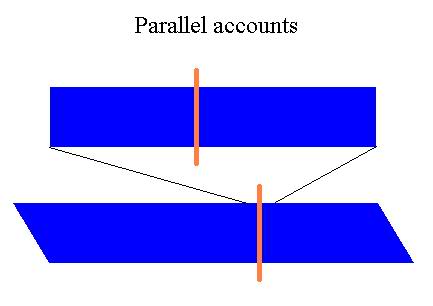You must "rightly divide" the Word, is a phrase oft heard, but how?
One old story telling technique is parallelism, where a broad overview is given, and then a detailed account which focuses on a section of the story of utmost importance.
The Bible contains several instances of parallel account construction in its various chapters. First and foremost is the book of Revelation. Parallel construction makes the reading hard when it is not recognized because the action, read from the beginning of the book to the end, is thoroughly mixed up with repeated events: like the multiple repetitions of one half of the one 'seven' in its various depictions being not twice, which would account for both, but five times.
Before looking at Revelation though, parallel construction is used right from the very beginning: Genesis.
In the Genesis account, there are two "creation" accounts. Scholars note the first as the "E" account for the use of Elohim, the plural of God found in chapters 1:1-2:3. Then quite abruptly, there is a "second" creation account Scholars call the "J" account for the personal name of God used in the Hebrew, "Yahweh" which is transliterated to "Jehovah".
In the first account, we get a broad overview of the entire creation account, all seven days. Noteworthy in this chronology, the seventh day has no end stated within the text.
In the second account, we get a personal interaction between Yahweh and Adam which sets up the whole reason of sin, death, Satan, the relationship between God and Man, the relationship between Adam and Eve, and their role within the world, now spoiled by sin.
The second account is fully set up as the creation account in 2:4. This second account then starts with a break for the first. It is interesting to note that while there is not "yet" any plant or shrub, these are qualified by being "of the field" which suggests cultivation. It does not preclude any plant because at the same time, God plants a garden rather than creates a garden. Likewise, from the first account, animals fill the sea and land before the creation of man, thus, while omitted from the first account, plant life would be necessarily in place prior to the establishment of man. So "of the field" becomes an important distinction; the two creation accounts do not conflict with each other.
Meanwhile, the second account repeats 1:24 in the second chapter and expands upon it. That is the purpose of the second, parallel account: to bring out essential information while setting that first in the broad scheme of things.
Parallel accounts can be viewed like this where a single verse like 1:24 is expanded to a whole new story.

One old story telling technique is parallelism, where a broad overview is given, and then a detailed account which focuses on a section of the story of utmost importance.
The Bible contains several instances of parallel account construction in its various chapters. First and foremost is the book of Revelation. Parallel construction makes the reading hard when it is not recognized because the action, read from the beginning of the book to the end, is thoroughly mixed up with repeated events: like the multiple repetitions of one half of the one 'seven' in its various depictions being not twice, which would account for both, but five times.
Before looking at Revelation though, parallel construction is used right from the very beginning: Genesis.
In the Genesis account, there are two "creation" accounts. Scholars note the first as the "E" account for the use of Elohim, the plural of God found in chapters 1:1-2:3. Then quite abruptly, there is a "second" creation account Scholars call the "J" account for the personal name of God used in the Hebrew, "Yahweh" which is transliterated to "Jehovah".
In the first account, we get a broad overview of the entire creation account, all seven days. Noteworthy in this chronology, the seventh day has no end stated within the text.
In the second account, we get a personal interaction between Yahweh and Adam which sets up the whole reason of sin, death, Satan, the relationship between God and Man, the relationship between Adam and Eve, and their role within the world, now spoiled by sin.
The second account is fully set up as the creation account in 2:4. This second account then starts with a break for the first. It is interesting to note that while there is not "yet" any plant or shrub, these are qualified by being "of the field" which suggests cultivation. It does not preclude any plant because at the same time, God plants a garden rather than creates a garden. Likewise, from the first account, animals fill the sea and land before the creation of man, thus, while omitted from the first account, plant life would be necessarily in place prior to the establishment of man. So "of the field" becomes an important distinction; the two creation accounts do not conflict with each other.
Meanwhile, the second account repeats 1:24 in the second chapter and expands upon it. That is the purpose of the second, parallel account: to bring out essential information while setting that first in the broad scheme of things.
Parallel accounts can be viewed like this where a single verse like 1:24 is expanded to a whole new story.


